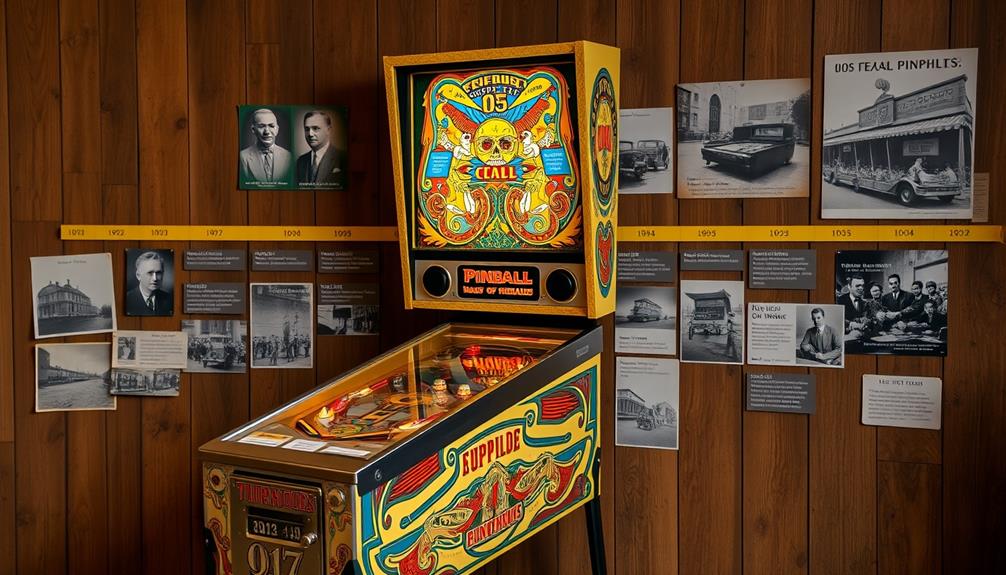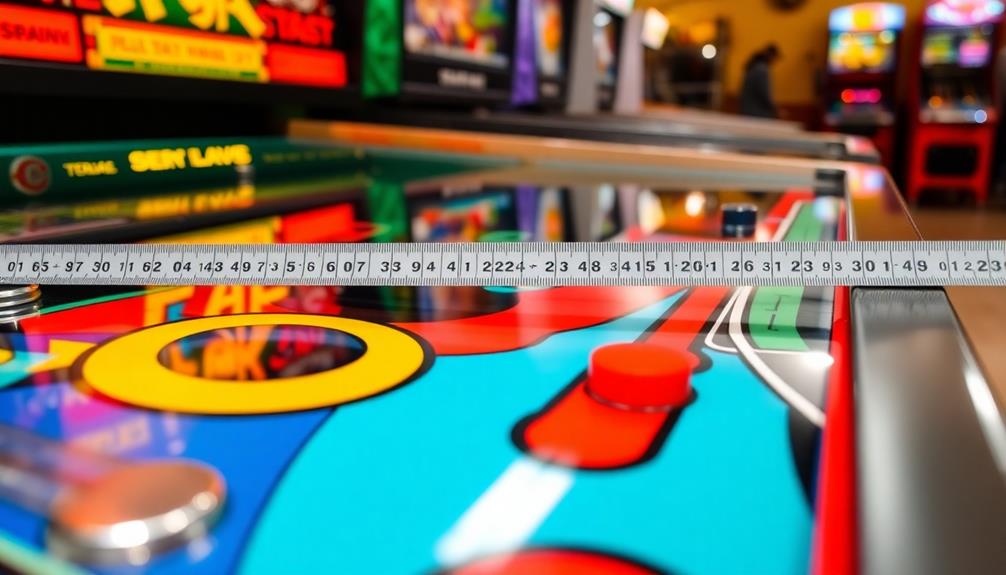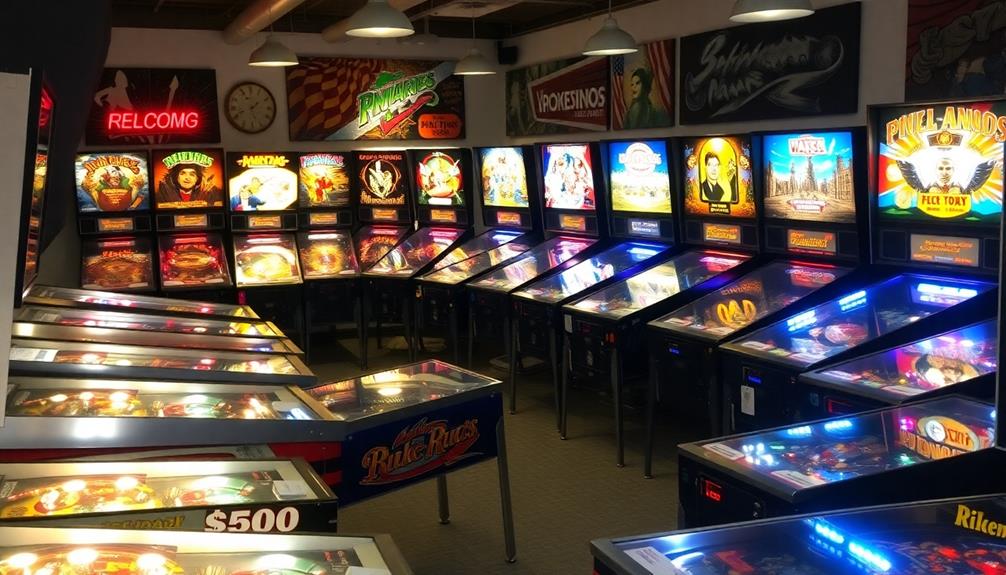Pinball has a rich history of over 250 years! The game originated in 18th century France as Bagatelle. The modern version emerged in 1871 when Montague Redgrave patented the coiled spring and plunger mechanism. By the 1930s, pinball machines gained popularity, especially with the introduction of coin-operated models. The term “pinball” was first used in 1936, solidifying its place as a popular form of entertainment. With the addition of flippers in 1947, the game evolved into a skill-based challenge. There is a wealth of information available for those interested in exploring its evolution and cultural significance!
Key Takeaways
- Pinball officially began with Montague Redgrave's patent in 1871, making it over 150 years old.
- The term "pinball" was coined in 1936, marking a significant identity milestone for the game.
- The introduction of flippers in 1947 transformed pinball into a skill-based game, evolving its gameplay.
- Pinball machines gained immense popularity during the Great Depression in the 1930s as low-cost entertainment.
- Legal challenges in the 1940s-1976 impacted pinball's accessibility, with New York City being one of the last to lift its ban.
Origins of Pinball
Pinball's origins trace back to the 18th century, when the game Bagatelle became popular in France. This early game involved players using a cue to hit balls into pockets on a wooden board, setting the stage for what would evolve into pinball. Notably, the charm and allure of such games may reflect the cultural beliefs surrounding entertainment and self-image, much like how astrology influences attractiveness.
Fast forward to 1871, and Montague Redgrave patented a new mechanism that introduced a coiled spring and plunger to propel the ball on an inclined board, laying the groundwork for modern pinball.
By the 1930s, the first coin-operated pinball machines began to emerge, with notable models like Bingo, Baffle Ball, and Ballyhoo engaging players. This marked a significant shift in how people interacted with the game, as it changed from a casual pastime to a coin-operated entertainment option. The term "pinball" was officially coined in 1936, helping to solidify the game's identity.
The introduction of flippers in 1947 transformed pinball into a game of skill, enhancing player engagement and strategy. Suddenly, you weren't just relying on chance; your skills determined your success, making pinball an exciting challenge that continues to draw players in today.
Official Invention Timeline

The timeline of pinball's invention reveals a fascinating evolution of this beloved game. It all began in 1871 when Montague Redgrave patented the official invention of pinball, introducing features like a coiled spring and a sloped board. Fast forward to the early 1930s, and you see the emergence of the first modern coin-operated pinball machines, such as Bingo, Baffle Ball, and Ballyhoo, which laid the groundwork for the industry.
By 1936, the term "pinball" gained traction, distinguishing the game as a unique form of entertainment. The gameplay shifted dramatically in 1947 when flippers were introduced, transforming pinball into a true game of skill rather than mere chance. However, pinball faced challenges; many U.S. cities imposed legal bans from the early 1940s until 1976. This ban was finally lifted following a court ruling that recognized pinball as a game of skill.
| Year | Event | Significance |
|---|---|---|
| 1871 | Montague Redgrave patents pinball | Official invention of pinball |
| 1930s | First modern coin-operated machines emerge | Paved the way for the pinball industry |
| 1947 | Flippers introduced | Shifted focus to skill |
| 1976 | Legal ban lifted | Acknowledged pinball as a game of skill |
Economic Growth and Popularity

During the Great Depression, pinball became a popular source of low-cost entertainment, giving people an affordable way to have fun.
The rise of global operations during this time created a demand for leisure activities, and the launch of the first automatic pinball machine in 1931 led to a surge in coin-operated machines, making them a common sight in social venues.
Great Depression Entertainment Boom
How did pinball transform into a beloved pastime amidst the economic turmoil of the Great Depression?
During the 1930s, pinball emerged as a low-cost entertainment option for people grappling with financial hardships. The introduction of the first automatic pinball machine in 1931 marked a turning point, leading to a surge in coin-operated machines across bars and social venues.
By 1933, pinball machines became a staple form of amusement, with companies like Gottlieb's Baffle Ball selling around 400 units daily, signaling the start of the coin-operated era. This newfound accessibility fostered a sense of community, as pinball became a shared experience that brought people together during tough times, illustrating the transformative power of curiosity and its role in social bonding.
Accessibility was key; pinball machines found their way into candy stores, pool halls, and amusement arcades, making them a popular attraction. This affordability allowed you and your friends to enjoy a shared experience, solidifying pinball's status as a significant social activity during the Great Depression.
As these machines populated urban environments, pinball not only provided a distraction from daily struggles but also fostered connections among players.
Ultimately, the entertainment boom surrounding pinball during this era helped it become ingrained in American culture, showcasing how a simple game could unite people during challenging times.
Coin-Operated Machine Proliferation
Pinball machines exploded in popularity throughout the 1930s as they became a staple of social interaction and entertainment in America. During the Great Depression, these machines provided a low-cost way to escape financial stress, appealing to many. The introduction of the first automatic pinball machine in 1931 marked a turning point, paving the way for the proliferation of coin-operated machines across the country.
This economic boom in leisure activities can be likened to the principles of budgeting, as individuals sought affordable entertainment options during challenging times.
By the mid-1930s, companies like Bally Manufacturing and Automatic Industries led the charge in developing successful models that captured the public's imagination. Coin-operated versions of games like Gottlieb's Baffle Ball laid the groundwork for the burgeoning pinball industry.
Baffle Ball, selling for just $17.50, allowed players to enjoy multiple plays for a mere penny, making it accessible to a wide audience.
As these coin-operated pinball machines became more common in bars and arcades, they transformed into a source of pride for players. High scores turned into local legends, with players often vying for rewards and recognition.
The economic growth of the pinball industry signified not just entertainment, but a cultural phenomenon that united communities during tough times.
Social Venue Staple
As you walk into a bar or arcade, the sounds of clinking coins and the cheerful ding of pinball machines instantly draw you in. During the Great Depression, these coin-operated marvels became a low-cost entertainment option for a financially strained public.
By 1931, the introduction of these machines led to their rapid spread in social venues like bars and pool halls across the United States. This era of pinball's rise mirrors the themes of positivity and warmth found in music like Blue Skies and Lemonade, capturing the essence of joy that such games provided.
By the late 1930s, pinball had firmly established itself as a popular form of entertainment, with machines like Ballyhoo selling tens of thousands of units.
The mid-1970s brought a pivotal moment when Roger Sharpe's courtroom testimony legalized pinball, reinforcing its identity as a game of skill rather than mere chance. This shift helped solidify its place in bars and other social settings.
As the 1990s rolled in, the merger of Bally and Williams revitalized the industry, leading to the creation of unique machines that piqued collector interest.
Today, pinball machines remain a cultural cornerstone in social venues, blending nostalgia with the thrill of competition and community, ensuring their legacy continues to thrive.
Legal Challenges and Regulations

Pinball faced significant legal hurdles from the early 1940s until 1976, with many cities banning the machines over concerns they promoted gambling.
The importance of quality assurance in software development is somewhat analogous to the challenges faced by pinball, as both require rigorous standards and advocacy to thrive.
The introduction of features like cash-out systems heightened fears, forcing advocates to fight back in court.
Roger Sharpe's testimony changed the game, proving pinball required skill and helping lift the bans, which allowed it to thrive again in entertainment venues.
Ban Duration and Reasons
For over three decades, pinball machines faced significant legal hurdles in major U.S. cities due to their perceived connection to gambling and organized crime. This long-standing ban, which lasted from the early 1940s until 1976, stemmed from several key concerns:
- The introduction of luminescent scorekeeping in the 1940s raised alarms about gambling potential.
- Bally's cash-out feature allowed players to collect winnings, heightening legal scrutiny.
- Pinball was often linked to organized crime, fueling negative perceptions.
- New York City was one of the last holdouts, finally lifting its ban in 1976.
Amidst these challenges, the emotional impact on players and operators was significant, as many lost livelihoods and recreational enjoyment.
The legal constraints surrounding pinball echoed the broader societal views on gambling and entertainment, similar to the legal process of divorce that often involves maneuvering through complex emotional and financial implications.
Roger Sharpe's courtroom testimony in 1976 played a pivotal role in shifting pinball's legal status. He successfully argued that pinball was a game of skill rather than luck, directly countering the gambling narrative.
This landmark moment not only changed the fate of pinball in New York City but also influenced regulations nationwide. The lifting of the ban marked a significant turning point, allowing pinball to reclaim its place in entertainment and culture, free from the heavy legal constraints that had previously shrouded it.
Court Case Impact
The landmark court case in 1976 not only redefined the legal landscape for pinball but also reshaped its cultural significance. Before this pivotal moment, pinball machines faced widespread bans in major U.S. cities, largely due to concerns that they promoted gambling and were linked to organized crime.
The introduction of features like luminescent scorekeeping heightened scrutiny, reinforcing the perception of pinball as a mere gambling device. This situation mirrors the fear of abandonment often experienced by individuals with Borderline Personality Disorder (BPD), where their identities can be influenced by societal perceptions and regulations.
However, Roger Sharpe's compelling testimony changed everything. He successfully demonstrated that pinball was a game of skill, rather than chance, which ultimately led to the lifting of the ban in New York City.
This ruling not only altered the legal status of pinball but also shifted public perception, as people began to view it as a legitimate form of entertainment.
With the subsequent legalization, pinball machines surged in popularity, finding homes in bars and arcades across the country.
This resurgence marked a significant turning point for the pinball industry, transforming it from a stigmatized pastime to a beloved cultural icon. As a result, you now enjoy a vibrant pinball scene that reflects its rich history and cultural evolution.
The Introduction of Flippers

Revolutionizing the game of pinball, flippers made their debut in 1947 with Gottlieb's "Humpty Dumpty." This innovation allowed players to actively control the trajectory of the ball, transforming what was once a game of luck into a skill-based challenge.
With flippers, the gameplay became more engaging, encouraging players to hone their skills rather than relying on chance. This shift towards skillful play mirrors principles found in effective preparation for interior design, where understanding the elements can lead to better outcomes.
Here are some key impacts of flippers on pinball:
- Increased Player Control: You can now direct the ball's path, making every shot essential.
- Shifted Perception: Pinball evolved from a game of chance to a game of skill, reducing negative associations with gambling.
- Enhanced Engagement: Players became more invested, as skillful play led to higher scores and longer games.
- Design Evolution: The introduction of outward-facing flippers in 1950's "Triple Action" further enhanced gameplay dynamics.
With flippers, the entire experience changed. You're not just hoping for the best; you're strategizing, aiming, and mastering the art of pinball.
This shift laid the groundwork for future innovations in the game, making it a beloved pastime for generations.
Technological Advancements

Flippers not only changed how players interacted with pinball machines but also paved the way for significant technological advancements in the game. The introduction of the first electrically powered pinball machine in 1933 brought sound effects generated through electromechanical bells and buzzers, enhancing the player experience. This shift towards immersive gameplay is an example of how content relevance and authority are prioritized in holistic SEO.
In 1937, Bally's Bumper introduced coil bumpers, further improving gameplay dynamics and making it more engaging.
The real revolution came in 1975 with Micro's Spirit of 76, the first solid-state electronic pinball machine. This shift from electromechanical pinball to solid-state technology transformed how games operated, allowing for more complex rules and features.
Today's modern pinball machines, like Stern Pinball's "Jurassic Park," showcase advanced features, including animatronics and interactive elements, that immerse players in thrilling experiences.
Manufacturers continue to push the boundaries with annual releases that highlight enhanced artwork and enchanting themes. These technological advancements not only keep the gameplay fresh but also attract a diverse audience, ensuring that pinball remains a beloved pastime.
As you play, you can appreciate how these innovations have shaped the game you enjoy today.
Resurgence in the 1990s

In the early 1990s, the pinball industry experienced a remarkable resurgence that captivated both old fans and new players alike. The merger of Bally and Williams revitalized the market, leading to innovative designs and unique machines that stood out.
One of the highlights was "The Addams Family," released in 1992, which became the best-selling pinball machine, with over 20,000 units produced.
This period saw a significant sales boom, driven by the combination of nostalgic themes and advanced technology. Collectors began to show increased interest in the unique machines from this era, further fueling the revival.
Here are some key factors that contributed to the resurgence:
- Innovative Designs: Manufacturers pushed the boundaries of creativity in their machines.
- Nostalgic Themes: Familiar franchises drew in players looking for a trip down memory lane.
- Collector Interest: Unique machines from the 1990s became highly sought after.
- New Manufacturers: Fresh companies entered the scene, bringing diversity to the offerings.
Digital Evolution of Pinball

As the 1990s pinball boom brought renewed interest in the game, it also paved the way for a digital evolution that transformed how players engage with pinball. The introduction of digital pinball video games allowed you to experience classic mechanics on computer and console platforms.
Particularly, "Pinball 2000," released in 1999, marked a significant milestone by merging traditional gameplay with video displays, incorporating animations and interactive elements to enhance your gaming experience.
Digital versions of classic pinball machines, like "Pinball FX" and "The Pinball Arcade," offer simulations that faithfully replicate real machines. This accessibility lets you enjoy a variety of themes and gameplay styles from the comfort of your home.
The rise of online platforms and mobile apps has broadened pinball's reach, connecting you with a larger community of enthusiasts.
While physical pinball machines often serve as collector's items, this digital shift has preserved the rich history of pinball, ensuring that new generations can appreciate its intricate mechanics.
The digital evolution not only revitalizes interest but also bridges the gap between the nostalgic past and the modern gaming landscape.
Future of Pinball Gaming

The future of pinball gaming looks bright, with innovative technology reshaping the experience for players. As we move forward, you can expect exciting developments that blend tradition with modernity.
Here are four key trends shaping the future of pinball:
- Advanced Interactive Features: Expect pinball games to incorporate LED lighting and large LCD monitors, enhancing the gameplay and attracting a new generation of electronic gaming enthusiasts.
- Emerging Manufacturers: New companies like Spooky Pinball and Heighway Pinball are entering the market, offering unique machines that integrate cutting-edge technology, ensuring diversity in gameplay.
- Resurgence of Retro Gaming: The renewed interest in retro gaming has led to a spike in demand for pinball machines, both in arcades and home collections, highlighting their timeless appeal.
- Community Engagement: Pinball tournaments and leagues are thriving, fostering social interactions and strengthening the community around pinball, making it more than just a game.
These trends show that pinball isn't just surviving; it's evolving.
Frequently Asked Questions
How Old Is Pinball Game?
You're looking at a game that's evolved considerably over centuries. Pinball, in its modern form, is over 150 years old, but its roots trace back to earlier games like Bagatelle, dating back even further. The game has gone through many changes and innovations, from the addition of flippers in the 1940s to the rise of electronic scoring and sound effects in the 1970s. The history of pinball machines is a fascinating journey through the development of entertainment technology, as well as a reflection of changing cultural trends and tastes. Despite facing bans and legal challenges in the past, pinball has endured and evolved, remaining a beloved pastime for people of all ages.
Why Was Pinball Illegal?
Imagine bustling streets, pinball machines hidden away like treasures, banned due to fears of gambling. You'd see authorities deeming them games of chance, mistaking skill for luck, until one brave voice changed it all in 1976.
What Is Pinballs Real Name?
Pinball's real name traces back to its origins in Bagatelle, a game popular in the 18th century. Over time, it evolved, but that early connection remains significant in understanding its history and development.
Was Pinball Popular in the 70S?
Pinball exploded like fireworks in the 70s, enchanting players everywhere. You'd find machines lighting up arcades and bars, as the flipper revolutionized gameplay. The thrill of skill over chance made it a must-try sensation.
Conclusion
In the world of gaming, pinball's journey is a tribute to the saying, "What goes around comes around." From its humble beginnings to the high-tech marvels of today, pinball has continually evolved while capturing our hearts. Whether you're a seasoned player or just discovering the thrill, remember that each game tells a story. So, embrace the flashing lights and clinking sounds; you're part of a vibrant history that's far from over. Let's keep the ball rolling!









